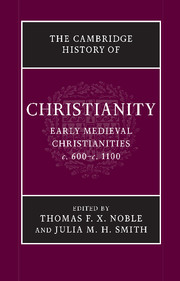Book contents
- Frontmatter
- Introduction: Christendom, c. 600
- Part I Foundations: Peoples, Places, and Traditions
- 1 Late Roman Christianities
- 2 The emergence of Byzantine Orthodoxy, 600–1095
- 3 Beyond empire I: Eastern Christianities from the Persian to the Turkish conquest, 604–1071
- 4 Beyond empire II: Christianities of the Celtic peoples
- 5 Germanic Christianities
- 6 Slav Christianities, 800–1100
- Part II Christianity in Confrontation
- Part III Christianity in the Social and Political Order
- Part IV Christianity as Lived Experience
- Part V Christianity: Books and Ideas
- Conclusion: Christendom, c. 1100
- Bibliographies
- Index
- References
6 - Slav Christianities, 800–1100
from Part I - Foundations: Peoples, Places, and Traditions
Published online by Cambridge University Press: 28 March 2010
- Frontmatter
- Introduction: Christendom, c. 600
- Part I Foundations: Peoples, Places, and Traditions
- 1 Late Roman Christianities
- 2 The emergence of Byzantine Orthodoxy, 600–1095
- 3 Beyond empire I: Eastern Christianities from the Persian to the Turkish conquest, 604–1071
- 4 Beyond empire II: Christianities of the Celtic peoples
- 5 Germanic Christianities
- 6 Slav Christianities, 800–1100
- Part II Christianity in Confrontation
- Part III Christianity in the Social and Political Order
- Part IV Christianity as Lived Experience
- Part V Christianity: Books and Ideas
- Conclusion: Christendom, c. 1100
- Bibliographies
- Index
- References
Summary
The coming of Christianity to the Slavs and Bulgars
To the inhabitants of the Balkans, whether members of Greek-speaking communities or newcomers, the phenomenon of the Roman Empire was virtually inescapable. In the provinces south of the Danube overrun by the Slavs in the seventh and eighth centuries, imperial authority of the traditional stamp had dissolved. The emperor’s writ was restricted to fertile coastal plains, whose inhabitants sought protection in fortresses and towns. The townsfolk, in turn, looked to their patron saints: St. Demetrius repeatedly had to intervene to stop Avars and Slavs from capturing Thessalonica and Patras almost fell to the Slavs at the beginning of the ninth century. A later tale claimed that, awe-struck by the sight of St. Andrew leading the charge against them, these Slavs sought sanctuary in his church; they and their properties were subsequently assigned to maintaining the church. Uncertain as events might be, both assailants and assailed could reckon upon the eventual return of regions of significance to imperial rule. Constantinople’s governors would never permit otherwise, as their ceaseless rounds of palace ceremonial broadcast: with God’s help “the Christians” would always prevail over “the nations” around them. This message, and its trappings, reached remote recesses of the Balkans and beyond. The Rus Primary Chronicle tells of a certain Kii’s visit to “Tsargrad” where the emperor received him with “great honor.” The legend is designed to show that Kii, eponymous founder of Kiev, enjoyed high status among his people. But it suggests what an honorific association with the emperor could do for aspiring chieftains – all the more so for those within range of Byzantine strike-forces.
- Type
- Chapter
- Information
- The Cambridge History of Christianity , pp. 130 - 156Publisher: Cambridge University PressPrint publication year: 2008
References
- 2
- Cited by



